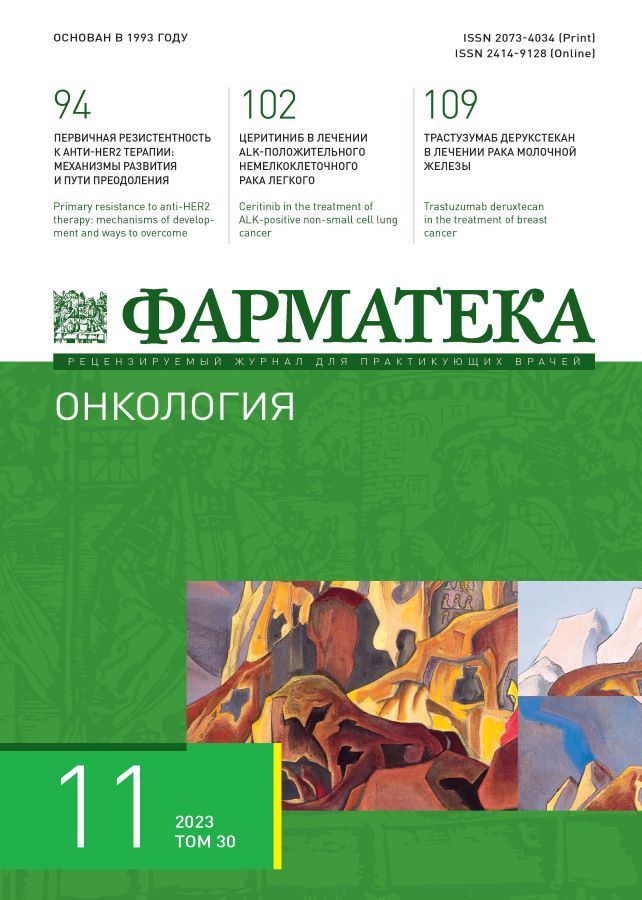Prevalence of chronic kidney disease among cancer patients
- 作者: Трофимцева Т.Н.1, Yarovoy S.K.2, Gritskevich A.A.3,4
-
隶属关系:
- Loginov Moscow Clinical Research Center
- Lopatkin Research Institute of Urology and Interventional Radiology – Branch of the National Medical Research Center of Radiology
- Vishnevsky National Medical Research Center for Surgery
- Patrice Lumumba Peoples’ Friendship University of Russia
- 期: 卷 30, 编号 11 (2023)
- 页面: 88-93
- 栏目: Original articles
- URL: https://journals.eco-vector.com/2073-4034/article/view/625815
- DOI: https://doi.org/10.18565/pharmateca.2023.11.88-93
- ID: 625815
如何引用文章
详细
Background. Information on the incidence, causes and severity of chronic kidney disease (CKD) in patients requiring antitumor drug therapy is limited in the literature. However, this information is essential for practical oncology and for the continuation of scientific research.
Objective. Evaluation of the CKD incidence among patients seeking oncological care, as well as its distribution by stage and relationship with oncological nosologies.
Methods. A retrospective study based on the analysis of medical records of 1500 patients followed-up at the City Clinical Hospital named after D.D. Pletnev in 2021 was conducted. The study included all patients who had a verified diagnosis of a malignant neoplasm. There were no exclusion criteria. Patients were divided into groups according to oncological diagnosis, the fact of pathogenetic antitumor therapy, CKD stage, and the main cause of renal failure (RF). Renal filtration function was assessed using CKD-EPI nomograms.
Results. A decrease in renal filtration was observed in 33% of oncological patients. In terms of incidence, CKD stage II and IIIa prevailed – 44.64 and 28.97%, respectively. Among oncological nosologies, CKD was most often observed in cancer of the kidney (21.21%), prostate (18.79%), bladder (16.97%), cervix (11.92%) and ovarian (9.09%). Irreversible renal pathology (nephrangiosclerosis, chronic pyelonephritis), a determining factor in the genesis of CKD, occurred in 54.08% of patients. Renal failure due to severe tumor intoxication was noted in 6.87% of patients.
Conclusion. CKD in oncological patients was common (33% of the total), mainly in the initial stages (II and IIIa – a total of 73.61%) and, mainly, in patients with urological and oncological gynecological profiles (a total of 77. 98%).
The main reasons for the deficiency of filtration function include concomitant chronic kidney pathology (nephrangiosclerosis, chronic pyelonephritis) and side effects of drug therapy (in total, 77.04%).
全文:
作者简介
Т. Трофимцева
Loginov Moscow Clinical Research Center
Email: grekaa@mail.ru
ORCID iD: 0009-0001-9324-878X
SPIN 代码: 9204-9426
俄罗斯联邦, Moscow
S. Yarovoy
Lopatkin Research Institute of Urology and Interventional Radiology – Branch of the National Medical Research Center of Radiology
Email: grekaa@mail.ru
ORCID iD: 0000-0003-4543-1480
SPIN 代码: 2848-7750
俄罗斯联邦, Moscow
A. Gritskevich
Vishnevsky National Medical Research Center for Surgery; Patrice Lumumba Peoples’ Friendship University of Russia
编辑信件的主要联系方式.
Email: grekaa@mail.ru
ORCID iD: 0000-0002-5160-925X
SPIN 代码: 2128-7536
Dr. Sci. (Med.), Head of the Department of Surgical Treatment of Urological Diseases, Professor at the Educational Department, Vishnevsky National Medical Research Center for Surgery; Professor at the Department of Urology and Operative Nephrology with a Course of Oncourology, Patrice Lumumba Peoples’ Friendship University of Russia
俄罗斯联邦, Moscow; Moscow参考
- Kalantar-Zadeh K., Jafar T.H., Nitsch D., et al. Chronic kidney disease. Lancet. 2021;398(10302):786–802. doi: 10.1016/S0140-6736(21)00519-5.
- Kovesdy C.P. Epidemiology of chronic kidney disease: an update 2022. Kidney Int Suppl. (2011). 2022;12(1):7–11. doi: 10.1016/j.kisu.2021.11.003.
- Nakamura Y., Tsuchiya K., Nitta K., et al. Prevalence of anemia and chronic kidney disease in cancer patients: clinical significance for 1-year mortality. Nihon Jinzo Gakkai Shi. 2011;53:38–45.
- Canter D., Kutikov A., Sirohi M., et al. Affiliation expand. Prevalence of baseline chronic kidney disease in patients presenting with solid renal tumors. Urology. 2011;77(4):781–85. doi: 10.1016/j.urology.2010.11.050.
- Launay-Vacher V., Gligorov J., Le Tourneau C., et al. Prevalence of renal insufficiency in breast cancer patients and related pharmacological issues. Breast Cancer Res. Treat. 2010;124(3):745–53. doi: 10.1007/s10549-008-0131-1.
- Wong G., Hayen A., Chapman J.R., et al. Association of CKD and cancer risk in older people. J Am Soc Nephrol. 2009;20:1341–50.
- Хроническая болезнь почек. Клинические рекомендации Научного общества нефрологов России, утвержденные Минздравом РФ. 2021 год. [Chronic kidney disease. Clinical recommendations of the Scientific Society of Nephrologists of Russia, approved by the Ministry of Health of the Russian Federation. 2021. (In Russ.)]. URL: https://rusnephrology.org/wp-content/uploads/2020/12/CKD_ final.pdf
- Launay-Vacher V., Oudard S., Janus N., et al. Prevalence of Renal Insufficiency in cancer patients and implications for anticancer drug management: the renal insufficiency and anticancer medications (IRMA) study. Cancer. 2007;110(6):1376–84. doi: 10.1002/cncr.22904.
- Dooley M.J., Poole S.G., Rischin D. Affiliation expand. Dosing of cytotoxic chemotherapy: impact of renal function estimates on dose. Ann Oncol. 2013;24(11):2746–52.
- Matzke G.R., Aronoff G.R., Atkinson A.J., et al.Drug dosing consideration in patients with acute and chronic kidney disease-a clinical update from Kidney Disease: Improving Global Outcomes (KDIGO).Kidney Int. 2011;80:1122–37.
- Evans M., Lewis R.D., Morgan A.R., et al. A Narrative Review of Chronic Kidney Disease in Clinical Practice: Current Challenges and Future Perspectives. Adv. Ther. 2022;39(1):33–43. doi: 10.1007/s12325-021-01927-z.
- Ciorcan M., Chisavu L., Mihaescu A., et al. Chronic kidney disease in cancer patients, the analysis of a large oncology database from Eastern Europe. PLoS One. 2022;17(6):e0265930. doi: 10.1371/journal.pone.0265930.
- Noce A., Marrone G., Di Lauro M., et al. The Onco-Nephrology Field: The Role of Personalized Chemotherapy to Prevent Kidney Damage. Cancers (Basel). 2023;15(8):2254. doi: 10.3390/cancers15082254.
- Habas E., Akbar R., Farfar K., et al. Malignancy diseases and kidneys: A nephrologist prospect and updated review. Medicine (Baltimore). 2023;102(15):e33505. doi: 10.1097/MD.0000000000033505.
补充文件











